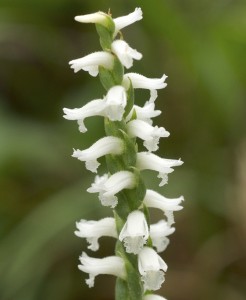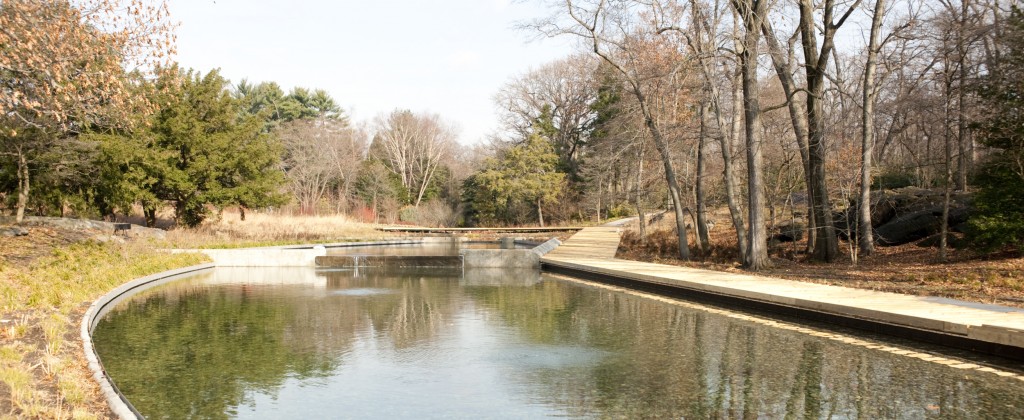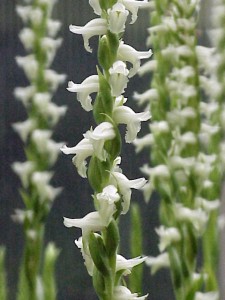New York’s Nodding Ladies
Posted in Gardens and Collections on December 19 2012, by Matt Newman
 Ladies’ tresses orchids aren’t the most flamboyant flowers in the redesigned Native Plant Garden. Neither are they the most exotic orchids you’ll ever come upon. But seeing them sprout up from the wetland area, I can’t help but find these local perennials engaging. Few people realize how widespread the world’s orchid population really is, and far from being the exclusive charge of southern climes and tropical islands, members of the Orchidaceae family range across much of the United States and into Canada. Naturally, that includes New York.
Ladies’ tresses orchids aren’t the most flamboyant flowers in the redesigned Native Plant Garden. Neither are they the most exotic orchids you’ll ever come upon. But seeing them sprout up from the wetland area, I can’t help but find these local perennials engaging. Few people realize how widespread the world’s orchid population really is, and far from being the exclusive charge of southern climes and tropical islands, members of the Orchidaceae family range across much of the United States and into Canada. Naturally, that includes New York.
But make no mistake: these aren’t the neon-painted Phalaenopsis orchids you see lining the shelves at your local florist, though their occasional fragrance makes up for such docile color. They’re small and narrow in profile, rising into a tall, green “spike” around which spirals a staircase of drowsy white flowers. They look a bit like stressed snowdrops, wound into coils that grow in stiff stands. Thriving in a wide range of habitats–fields, damp meadows, moist thickets and grassy swamps among them–that clean simplicity might explain the allure of this New York City orchid.
I asked Jody Payne, Director of the Native Plant Garden, to help me understand why these particular orchids were chosen for the space, opening soon after the warm weather returns in 2013.
“These are known as Spiranthes cernua, or nodding ladies’ tresses orchids, one of many species of Spiranthes in the northeastern United States. They are native to New York and often found in wet meadows, from Ontario and Nova Scotia down to Georgia and west to Texas. The flowers spiral up the stem, giving the plant its name. As for why we decided to include them in the Native Plant Garden, not only are they native, but they make wonderful garden plants that flower in the fall–a welcome trait, as so few species flower at that time.”

Here in the northeast, ladies’ tresses can be cultivated in partial to full sun if grown on a moist or wet site, with seed pods and flowering stems removed after a late fall frost to stimulate root and daughter-plant growth. Taking divisions of tubers from mature plants during the dormant period makes propagation easier, though slow and steady colony growth can be expected if, with the right conditions, the orchid is left to its own devices. With a modicum of attention paid to these slender natives, a small but healthy group of plants isn’t too much of a challenge to maintain at home.
 While the Native Plant Garden is set to become a powerful educator on the benefits of New York’s native species, it’s important to remember that collecting your plants from the wild is a serious faux pas, both on an ethical and–occasionally–a legal level. Depending on your region, even species such as Spiranthes cernua may be protected by law. And fines or not, you don’t want to be responsible for depleting the wild population of a threatened species; always be sure to procure your native plants from a nursery which propagates its offerings vegetatively.
While the Native Plant Garden is set to become a powerful educator on the benefits of New York’s native species, it’s important to remember that collecting your plants from the wild is a serious faux pas, both on an ethical and–occasionally–a legal level. Depending on your region, even species such as Spiranthes cernua may be protected by law. And fines or not, you don’t want to be responsible for depleting the wild population of a threatened species; always be sure to procure your native plants from a nursery which propagates its offerings vegetatively.
I’ll be covering more from the Native Plant Garden as we inch closer to its 2013 grand opening (and I can tell you without a shred of hyperbole that it’s turning into one of the most inspiring landscapes in the NYBG). It all happens on Plant Talk, so keep it here for all the nudging you’ll need to go native at home.
Spiranthes photos courtesy of Wikimedia Commons.

